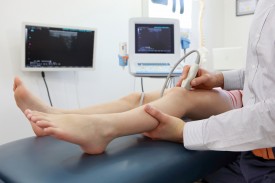For many people, the term “ultrasound” conjures images of expectant mothers seeing their babies for the first time. While this is one of the most common applications of ultrasound technology, it’s far from the only one - in medicine or in nature.
Ultrasound means exactly what it implies - it’s a term for sound waves at such an ultra-high frequency that humans can’t detect it. It’s the method used by bats and dolphins to navigate and hunt for prey, by seafaring vessels to measure depth and distance, and by physicians to take images of the inner workings of the human body.
At the Orthopaedic and Sports Medicine Center, ultrasound is used as an alternative to techniques like X-Ray. According to Dr. Peter Hodges of OSMC, the use of ultrasound avoids the drawbacks of other techniques, and comes with some advantages of its own.
“It’s non-invasive, it’s more cost-effective then performing fluoroscopic guided injections,” said Dr. Hodges. “Ultrasound is a modality that can help us better localize the needle when we are doing injections in areas of the body that usually require real time X-ray, such as hip injection. Injections that were previously performed in a specialized X-ray suite can now be done in our clinic, in the patient exam room.”
Injections are a common practice at OSMC for diagnostic and therapeutic purposes. For example, if a patient complains of pain in a specific area, and a doctor injects a local anesthetic around the area that is painful, if symptoms subside, it helps the doctor narrow the problem down to that particular area.
“With ultrasound, you can actually see the fluid flow around the biceps tendon as you inject,” said Dr. Hodges. “Prior to having ultrasound in the clinic, we would use anatomic landmarks to help us localize the injection. With ultrasound we can confirm that the injection is localized to the area that is most important.”
Injections are particularly tricky in the hip and in some areas of the shoulder, Dr. Hodges said. Since pain in these joints is a common complaint of patients seeking orthopaedic care, the ability to visualize the injection process with ultrasound greatly improves OSMC’s ability to diagnose and treat pain efficiently and effectively.
Another benefit of ultrasonic imaging is the avoidance of harmful X-Ray radiation. This is a nice bonus for patients - it’s always preferable to avoid exposure to radiation - but it can be crucial for doctors, who may be exposed to X-ray radiation throughout their careers. Surgeons are exposed to X-ray radiation when using real time X-ray, also known as fluoroscopy, during surgical procedures or when doing injections.
At OSMC, ultrasound contributes to our overall strategy to maximize comfort, efficiency, and quality in patient care. Get in touch with us today to see if OSMC can help you live a healthier, more functional lifestyle.

